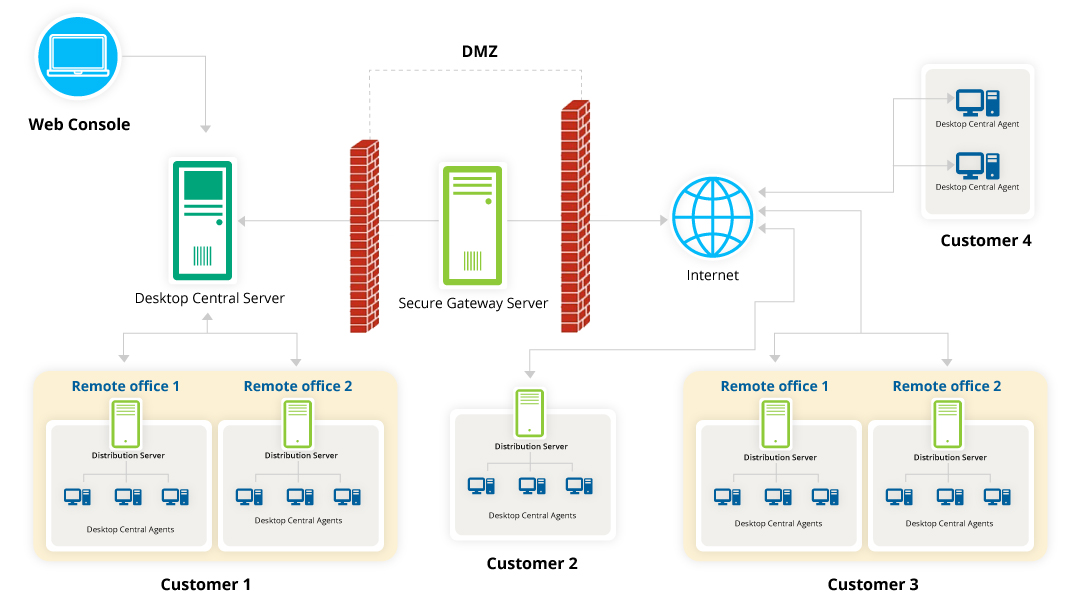ManageEngine Endpoint Central MSP is a Web-Based windows desktop administration software that helps administrators to effectively manage the desktops from a central point. It provides Configurations, Inventory Management, Patch Management, Service Pack Installation, Software Installation, Desktop Sharing, and System Tools.
The figure below depicts the Endpoint Central Architecture. The details of the individual components are given below:

Fig:Endpoint Central MSP Architecture
Components of Endpoint Central MSP architecture:
Endpoint Central MSP Server:
Endpoint Central MSP Server has to be installed in MSP head office and has to be configured as an EDGE device. This means that the designated ports, 8040 and 8041 (configurable) should be accessible through the Internet. The Server pushes the Endpoint Central MSP agent to the client machines, deploys configurations, initiates scanning for Inventory and Patch Management to manage the desktops in the customers network effectively. It is advised to keep the Endpoint Central MSP server always running to carry out the day-to-day Desktop Management activities.
All these actions can be initiated from a web-based administration console in a few simple clicks.
AD Connector:
To leverage the complete functionalities of an AD based setup to perform day-today management activities since the Endpoint Central MSP server is outside the network, Endpoint Central MSP has come up with a component called the AD Connector which acts as a communicator between the Endpoint Central MSP server and the Domain Controller of an organization. It is mandatory for the AD connector to be one of the Distribution Servers (DS) within the organization. When a customer with multiple remote offices is managed by Endpoint Central MSP, one of the Distribution Server is configured as the AD connector.
Distribution Server:
Endpoint Central MSP Distribution Server is light-weight software that is installed in one of the computers in the Customer Offices. This agent will communicate with the Endpoint Central MSP Server to pull the information for all the computers in that customer's branch office. The agents that reside in the branch office computers will contact the Distribution Server to get the information available to them and process the requests. This results in low bandwidth utilization as only one agent will contact the Server periodically. When there are multiple Distribution Servers for a customer, one of the DS will act as an AD connector.
Endpoint Central Agent:
Endpoint Central MSP Agent is light-weight software that is installed in the client systems that are being managed using Endpoint Central. It acts as a worker to carry out the operations as instructed by the Endpoint Central Server. Endpoint Central MSP agent can either be installed manually or through the Distribution Server in all the customer computers that are being managed using Endpoint Central MSP.
For computers in customer branch Offices, the agent will contact the Distribution Server to PULL the configurations available for them, deploys them and updates the status back to the Server.
Notification Server:
The Notification Server is a component which is residing in the Endpoint Central MSP Server. Notification Server is a TCP connection which used the port 8057, when an on-demand task is to be executed. When an on-demand task is initiated, the Notification Server communicates with the Endpoint Central MSP agent regarding the on-demand action to be performed in the particular client machine.
Web Console:
The web console provides a central control point for all the desktop management functions. It can be accessed from anywhere:- LAN, Remote Offices, and Home through Internet/VPN. No separate client installations are required to access the web console.
Secure Gateway Server:
Click here to know in detail about the secure gateway server in Endpoint Central MSP.
Ports:
Click here to know in detail about the ports.